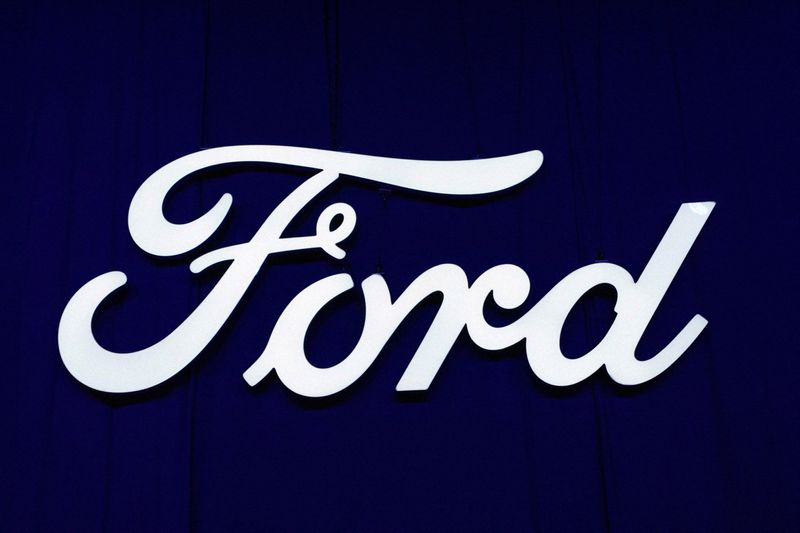By Joseph White and Nathan Gomes
DETROIT (Reuters) -Ford Motor shares jumped on Tuesday after the automaker said it will return more cash to shareholders, starting with an extra 18 cents-per-share dividend in the first quarter, joining General Motors (NYSE:GM) in giving investors more of the cash spinning from North American combustion trucks.
Ford (NYSE:F) forecast $10 billion to $12 billion in pretax profit for 2024, after earning $10.4 billion before taxes last year.
Profit from Ford's Pro commercial vehicle business and Ford Blue combustion vehicle units offset steep losses from Model E electric vehicle operations.
Ford is slowing investment in new EV capacity to match slower demand following a seismic change in EV pricing over the past year, Ford executives told analysts.
The next generation of Ford EVs will be launched "only when they can be profitable," Marin Gjaja, head of the Model E EV business, told analysts Tuesday.
Ford's North American truck and SUV business - both commercial and consumer - will contribute to projected free cash flow of $6 billion to $7 billion this year. Ford has committed to return to investors 40% to 50% of free cash flow.
"Whenever that (regular) dividend doesn’t reach 40-50% we will provide a supplemental dividend," Chief Financial Officer John Lawler told reporters on a conference call on Tuesday.
"Consistency is going to be very important," he said.
Ford shares were up 6.1% in after-hours trading after gaining 4.1% during the regular session. The shares so far this year have dipped 0.7%.
Ford's electric vehicle operations will continue to be a cash drain this year.
Model E lost an average of more than $47,000 per vehicle in the fourth quarter, Ford reported. The company projected a wider pretax loss of between $5 billion and $5.5 billion this year.
Ford's next generation of EVs "will be profitable and return their cost of capital," Lawler said.
But Ford's EVs will not return 8% pretax profit margins by 2026 - a goal set in early 2023, Lawler said. "I don’t think anybody believes we can bridge from here to 8% by 2026."
General Motors told investors last week it expects its North American EVs to cover their production costs and generate a variable profit by the second half of this year.
Ford is overhauling its EV strategy in response to slower adoption by mainstream consumers and the price war launched by Tesla (NASDAQ:TSLA), Chief Executive Jim Farley told analysts during a call on Tuesday.
Ford plans to invest in larger EVs such as trucks and vans. A "skunk works" team is developing a low-cost small EV architecture, Farley said.
The automaker will invest more in gas-electric hybrids, which command profit margins that "are much higher than EV margins," he said. Hybrid sales could grow by 40% next year, Farley said.
"The EV business needs to stand on its own, it needs to be profitable and provide a return" above its cost of capital independent from emissions compliance benefits, Lawler said.
Every electric F-150 Lightning Ford sells allows it to sell 12 combustion pickup trucks and stay in compliance with U.S. emissions rules, Lawler said.
Ford Pro, the automaker's commercial business, will be a key driver of profit and potential cash returns to investors this year. Ford Pro is forecast to earn $8 billion to $9 billion this year, up from $7.2 billion in pretax profit last year.

Increased sales of redesigned Ford's Super Duty pickup trucks in North America following a slow launch last year are behind the assumption of higher Ford Pro profits, Ford executives said.
Ford Pro also expects to gain sales with new electric Transit vans in Europe, where some cities are banning combustion vehicles in central districts, Farley said. Ford's rival, GM, last week delivered an optimistic outlook for 2024, and Chief Executive Mary Barra signaled shareholders will get more of the cash spinning from sales of GM's combustion trucks and SUVs through share buybacks. Cost cuts and demand for crossover SUVs and pickup trucks helped automakers offset inflationary headwinds and early signs of EV demand cooling. Consumers opted for hybrid vehicles and family SUVs instead of EVs for convenience and relative ease in terms of maintenance. In response, Ford and GM, which were putting together ambitious EV plans, have begun leaning toward their higher-margin hybrid and gas-powered models.
